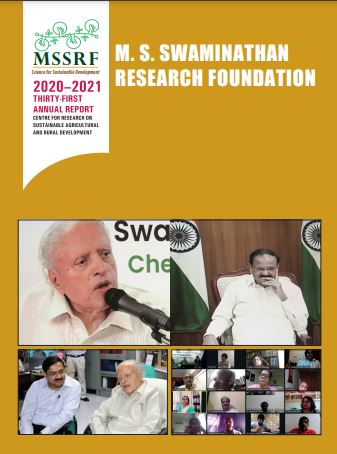International Conference 2021
This fortnight e-synergy has some of the eminent participants’ videos who speak on various issues related to food and agriculture.
DownloadTraditional knowledge of medicinal plants and herb-based home-remedy systems are popular in India. Age-old Ayurveda system of treatment and thousands of folk practices that flourished were well-accepted by the people of Kerala. Wayanad district is well-known for its medicinal plant wealth and community knowledge associated with it. Conversely, the natural population of most of the potential medicinal species and rich traditional knowledge in the region are dwindling at an alarming pace.
Read MoreLandraces of millets are preferred by farm families since time immemorial not only for their high nutritional qualities, but also inherent capacities to withstand weather changes, and for pest and disease resistant traits. Although, these crops are part of the food culture in Kolli hills (Eastern Ghats of Tamil Nadu), over the last three decades farmers have moved to cultivating cash crops like cassava, coffee and pepper.
Read MoreTribes are from the underprivileged section of society and often live in marginal physical environment. Migration is a significant phenomenon among Malyali tribes. Small land holdings, lack of work, and higher wages prompt them to migrate in search of livelihood. Additionally, growing cash crops abundantly has reduced their access to fruits, vegetables and millets that once grew in their fields.
Read MoreKoraput district in Odisha is largely a rural, agrarian economy. Declining land-holdings, poor incomes, and threatened nutrition security, combined with the consequences of climate change, pose a serious challenge for sustainable livelihoods. The gradual shrinking of land-holdings can be dealt with by pooling together land-based enterprises like fishery, poultry, duckery, apiary, field and horticultural crops, etc.
Read MorePulses are an important source of proteins, vitamins, and minerals, predominantly cultivated in rainfed agroecology. They are best suited to be cultivated in both Kharif and Rabi seasons in diverse cropping systems as sole crops, intercropping, relay crops, rice fallow crops, mixed crops, etc. India is the largest producer, consumer, and importer of pulses. Tamil Nadu has 4.08 per cent of the total cultivated area under pulses.
Read MoreAgriculture is the major livelihood in semi-arid agro-ecosystems in Reddiarchatram Block, Dindigul district. Sugarcane, banana, paddy and vegetables were the dominant crops cultivated intensively in all three seasons in the past. But in the recent past, it has been shifted to maize, cotton and vegetables and is reduced to just one season rather than two to three seasons. Groundwater levels have been declining drastically as well.
Read MorePests and diseases cause significant crop losses and income to farmers. Timely diagnosis of the issue (including pest, disease and nutritional deficiencies) that hamper crop growth is necessary to minimise production losses. However, the existing agricultural extension systems do not have adequate capacity to extend farmer-centric plant health advisories.
Read MoreMoringa (Moringa oleifera) popularly known as Drumstick, is less water requiring and economically important crop, which is increasingly being cultivated by smallholders. In Tamil Nadu, Moringa is widely cultivated in Dindigul, Karur and Coimbatore districts. The crop is cross-pollinated, and insects are essential for pollination.
Read MoreWithout a scientific GIS Plan, engineers with the Department of Rural Development (DRD), Government of Tamil Nadu, found it a challenge to implement the Natural Resource Management (NRM) and non-NRM works in Gram Panchayats (GPs) allotted under the Mahatma Gandhi National Rural Employment Guarantee Act (MGNERGA) budget.
Read MoreTiruvannamalai district has several isolated hillocks at a minimum height of 120 metres above sea level. Most of the hillocks are in a degraded state causing severe losses in crucial ecosystems services. Restoration requires that there be a scientific approach to plan and implement locally suitable solutions.
Read More
This fortnight e-synergy has some of the eminent participants’ videos who speak on various issues related to food and agriculture.
Download